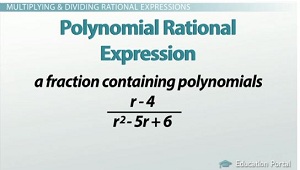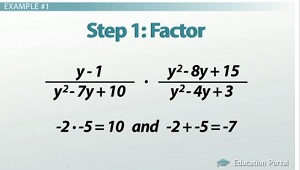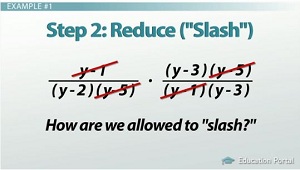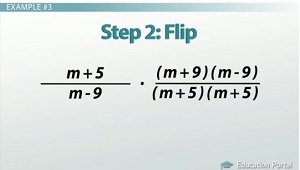How to Multiply and Divide Rational Expressions
After you watch the video and know the material, click HERE for the quiz.
Multiplying and dividing rational polynomial expressions is exactly like multiplying and dividing fractions. Like fractions, we will reduce. With polynomial expressions we use factoring and canceling. I also give you a little mnemonic to help you remember when you need a common denominator and when you don't.
Multiplying and Dividing Rational Expressions
 |
A polynomial rational expression is a fraction containing polynomials. Example of a rational expression: (r - 4) ÷ (r² - 5r + 6)
Today we're going to look at multiplication and division of rational polynomial expressions. Remember how we multiplied fractions? We multiplied straight across the fractions. The same rule applies to rational polynomial fractions. It's just like 1/2 * 3/5, where we multiply straight across to get 3/10.
Division of fractions requires use to 'flip' the second fraction. You got it! That rule also applies to rational fractions. It's just like with 1/9 ÷ 2/7, where we flip the second fraction and change it to multiplication, so we have 1/9 * 7/2. Multiply straight across, and we get 7/18.
So is it really that easy? Almost. We need to add a couple new steps, but they aren't too bad.
Example #1
((y - 1) ÷ (y² - 7y + 10)) * ((y² - 8y + 15) ÷ (y² - 4y + 3)
 |
First, we need to get the polynomials in simplified form. That means factoring. Let's review factoring. Let's look at y² - 7y + 10. We're looking for multiples of 10 that add to -7.
-2 * -5 = 10, and -2 + -5 = -7. So y² - 7y + 10 factors into (y - 2)(y - 5).
How about y² - 8y + 15? Well, -3 * -5 = 15, and -3 + -5 = -8, so y² - 8y + 15 factors into (y - 3)(y - 5).
And then y² - 4y + 3 factors into (y - 1)(y - 3).
So it turns out we have:
((y - 1) ÷ ((y - 5)(y - 2))) * (((y - 3)(y - 5)) ÷ ((y - 1)(y - 3)))
The second new step is reducing, or what I like to call slashing! You can only reduce from top to bottom - never reduce from side to side! Once you have 'slashed' all of the like terms from the top and bottom, we multiply straight across. Don't multiply anything we slashed!
We can cancel (y - 5) over (y - 5) and (y - 1) over (y - 1).
 |
Are you asking yourself, why we can cancel? Well, we know that 4 ÷ 4 = 1; then (y - 3) ÷ (y - 3) also equals 1, so we slash those, too! Once we've 'slashed' all of the like terms from the top and bottom, we multiply straight across. Don't multiply anything we slashed! Why? Because those are now 1s!
It turns out that ((y - 1) ÷ (y² - 7y + 10)) * ((y² - 8y + 15) ÷ (y² - 4y + 3)) = 1 ÷ (y - 2).
Example #2
Let's look at ((r - 4) ÷ (r² - 5r + 6)) ÷ ((r - 3) ÷ (r² - 6r + 9)).
First, we need to get the polynomials in simplified form, and that means factoring. Let's review again factoring. Let's look at r² - 5r + 6. We're looking for multiples of 6 that add to -5.
-3 * -2 = 6, and -3 + -2 = -5. So r² - 5r + 6 factors into (r - 3)(r - 2).
How about r² - 6r + 9? Well, -3 * -3 = 9 and -3 + -3 = -6, so r² - 6r + 9 factors into (r - 3)(r - 3).
Our expression with simplified polynomials now looks like:
((r - 4) ÷ ((r - 3)(r - 2))) ÷ ((r - 3) ÷ ((r - 3)(r - 3)))
We aren't done yet. To divide fractions, we need to 'flip' the second fraction. So, we have:
((r - 4) ÷ ((r - 3)(r - 2))) * (((r - 3)(r - 3)) ÷ (r - 3))
The second step is canceling, or what I like to call slashing! Once we have 'slashed' all the like terms from the top and bottom, we multiply straight across, but don't multiply anything we slashed! So we're going to slash (r - 3) over (r - 3) and (r - 3) over (r - 3).
It turns out that ((r - 4) ÷ (r² - 5r + 6)) ÷ ((r - 3) ÷ (r² - 6r + 9)) = (r - 4) ÷ (r - 2).
Example #3
Let's look at ((m + 5) ÷ (m - 9)) ÷ ((m² + 10m + 25) ÷ (m² - 81)).
First, we need to get the polynomials in simplified form. That means factoring. Factoring m² + 10m + 25, we get (m + 5)(m + 5). Factoring m² - 81, we get (m + 9)(m - 9). So our expression now looks like:
((m + 5) ÷ (m - 9)) ÷ (((m + 5)(m + 5)) ÷ ((m + 9)(m - 9)))
 |
Next, flip! We flip the second fraction and change it to a multiplication. So our expression now looks like:
((m + 5) ÷ (m - 9)) * (((m + 9)(m - 9)) ÷ ((m + 5)(m + 5))).
Before we have our final answer, we cancel, or 'slash,' like terms. I love this part! We slash (m + 5) over (m + 5) and (m - 9) over (m - 9). Once we have 'slashed' all of the like terms from the top and the bottom, we multiply straight across. Don't multiply anything we slashed!
It turns out that ((m + 5) ÷ (m - 9)) ÷ ((m² + 10m + 25) ÷ (m² - 81)) = (m + 9) ÷ (m + 5).
Lesson Summary
Multiplication and division of rational expressions is easy once you remember these steps!
Multiplication
- Factor
- Slash
- Multiply
Division
- Factor
- Flip
- Slash
- Multiply
 |
One final note - many of my students think they need to get a common denominator when multiplying or dividing fractions. No, no, no! Never! Only when you add and subtract, so please don't make that same mistake.
Try this mnemonic to help you remember:
Add Subtract Common Denominators, Multiply Divide None.
Auntie Sits Counting Diamonds, Mother Does Not.